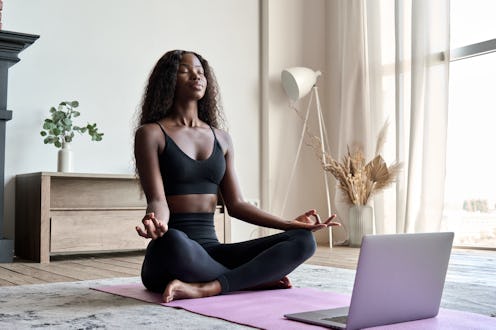
It feels so good to roll out a mat, take some deep breaths, and flow your way through some stretchy poses — which might lead you to wonder how often you should do yoga in order to reap its many benefits.
If you’ve ever tried yoga, then you know that the fitness modality is an ideal way to become more flexible while building strength, says Janie Gianotsos, a certified yoga instructor. But there’s so much more to gain from the practice than exercise. People who do yoga on a regular basis tend to experience more relaxation and an improved mood, and they have an easier time regulating tough emotions, she tells Bustle. It’s just as good for your mind as it is for your arms, core, and posture.
Still, however great it may feel physically and mentally, it’s easy to just... not do yoga or put it off for another day, especially when you aren’t in the mood to bend or sweat. What’s more, if you’re getting back into yoga after taking a break or giving it a go for the first time, it’s common to experience muscle tightness that can be uncomfortable to the point you don’t want to try again, says Kendra Berner, a yoga instructor at wellness studio Activate House. Add in a busy schedule, and the excuses for stowing your mat can really start to add up.
If you’re looking to find your groove and get all the juicy benefits of yoga, here’s what experts say about how often you’ll need to do it.
How Often Should You Do Yoga?
In an ideal world, you’d aim to do yoga for 30 to 60 minutes every day, Gianotsos says. “My own practice is daily yoga nidra, or meditation, for 15 to 30 minutes and at least 15 to 30 minutes of asana [another word for yoga poses],” she says. “If I have time for more, I like to practice asana for a full hour.” You might work up to this amount of yoga as you get used to your practice, but it’s still beneficial to do just one yoga session a week.
“Students who do yoga once a week notice a difference in the other workouts they complete, and may notice more connection to their physical well-being,” Berner says. Muscle tension melts away, other movements will feel easier, and you might even find that you’re a little more flexible or aware of your body, she says. Turn that once-a-week session into a habit and you may find that you can start increasing to two to four sessions a week, Berner says.
Doing some yoga on an irregular basis is always better than no yoga at all, Gianotsos adds, so even if you can’t stick to a strict schedule it’s still worth it to roll out your mat — even if it’s just for five minutes. “Start at a level that feels comfortable to you,” Gianotsos says. “Yoga is not a competitive sport — it's a journey based on where you are when you start. You should do what feels OK in your body and not push too hard.”
How To Make Yoga Part Of Your Routine
As with any habit, Gianotsos says you might encounter a few speed bumps as you figure out how to incorporate more yoga into your life. Like drinking more water or getting enough sleep, it can be tough to make good habits stick when you try to change too much at once — so slowly ease into it.
“There are some great 15-minute online classes you can try,” she says. “Plus, many studios offer beginner workshops and classes, which are great if you've never tried yoga or need a refresher. Pace yourself and experience different styles of yoga to find what works for you.” You might realize that you’re into fast-paced power yoga classes or that you’re more likely to come back to your mat when you do slower hatha flows.
Whatever you do, Gianotsos recommends exploring your practice with curiosity and consistency. While there may be an “ideal” amount of yoga to do, you’ll always get the most out of it when you make it your own.
Studies referenced:
Csala, B. (2021). Is Weekly Frequency of Yoga Practice Sufficient? Physiological Effects of Hatha Yoga Among Healthy Novice Women. Front Public Health. doi: 10.3389/fpubh.2021.702793.
Madhivanan, P. (2021). Yoga for Healthy Aging: Science or Hype? Adv Geriatr Med Res. doi: 10.20900/agmr20210016.
Ross, A. (2012). Frequency of yoga practice predicts health: results of a national survey of yoga practitioners. Evid Based Complement Alternat Med. doi: 10.1155/2012/983258.
Woodyard, C. (2011). Exploring the therapeutic effects of yoga and its ability to increase quality of life. International Journal of Yoga, 4(2), 49-54. https://doi.org/10.4103/0973-6131.85485
Sources:
Janie Gianotsos, certified yoga instructor
Kendra Berner, yoga instructor at wellness studio Activate House